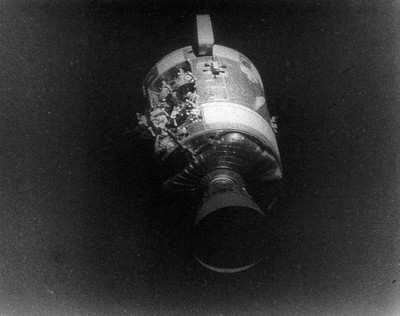Innovative, Fast-Thinking, Adaptable...
By ANN Senior Editor Pete Combs
It's not that there haven't been problems. Since Discovery
launched ten days ago, the shuttle crew has had to deal with
falling foam, dangling gap-filler and tears in a thermal blanket.
That a complex machine like the shuttle has issues is not
unexpected. That NASA has returned the shuttle to flight with a new
attitude is what impresses me most.

In fact, I like what I see because there have been problems with
gap-filler and thermal blankets. What I like is NASA's innovation
-- the ability to turn on a dime, think fast and act decisively.
This is the NASA of Jim Lovell and Neil Armstrong.
 Take the gap-filler problem. Again,
it's probably an issue that came up in shuttle missions before the
Columbia disaster two years ago -- but nobody was looking. But in
the wake of Columbia's February 2003 disintegration, NASA is eyeing
the shuttle like a small child on a busy street and the tiny
strands of ceramic-covered fabric were caught in the brilliant
glare of that ongoing scrutiny.
Take the gap-filler problem. Again,
it's probably an issue that came up in shuttle missions before the
Columbia disaster two years ago -- but nobody was looking. But in
the wake of Columbia's February 2003 disintegration, NASA is eyeing
the shuttle like a small child on a busy street and the tiny
strands of ceramic-covered fabric were caught in the brilliant
glare of that ongoing scrutiny.
NASA engineers did this week what NASA engineers did in April,
1970 when Apollo 13 was nearly lost to an in-flight explosion
(below). They worked around the clock to improvise ways for
astronauts Jim Lovell, John Swigert and Fred Haise, Jr. to stay
alive while they also improvised ways to get the crippled mission
home.
Earlier this week, engineers on the ground created a hacksaw out
of parts available to the astronauts, then told the astronauts
themselves how to do the same. They created a repair mission for
the EVA team and that mission was performed flawlessly. It was sort
of like watching Robin Williams on stage -- the more he ad-libs,
the better he performs. The tougher the pressure, the better the
product.

Through all that's happened in space this week, I got the
distinct impression that NASA's aversion to risk has certainly
thawed. As X-Prize founder Peter Diamandis told me during last
week's AirVenture 2005 in Oshkosh, WI, NASA has been virtually
frozen by its aversion to risk and its unwillingness to deviate
from a plan.
What a difference from the events leading up to the Columbia
disaster -- and in that, you can see that NASA's culture has truly
changed. As ANN reported two years ago, mission leaders
refused to take seriously the possibility that the light-weight
foam covering the shuttle's external fuel tank might flake off
during launch and damage the orbiter.
 Yet, right there on audio tape,
recorded during a nationwide conference call, is the voice of Linda
Ham (right), a shuttle manager at the Johnson Space Center in
Houston (TX):
Yet, right there on audio tape,
recorded during a nationwide conference call, is the voice of Linda
Ham (right), a shuttle manager at the Johnson Space Center in
Houston (TX):
"(T)he material properties and density of the foam wouldn't do
any damage," shuttle manager Linda Ham said in a conversation with
engineer Don McCormick. "Really, I don't think there is much we can
do," Ham said in the January 21st conference call. "It's not really
a factor during the flight because there isn't much we can do about
it."
Now, NASA engineers are aggressively -- some might say, too
aggressively -- monitoring each possible source of danger to the
spacecraft and its crew. And with the sort of pluck made famous by
beleaguered cosmonauts aboard Russia's Mir space station, engineers
on the ground and crews in space are determined to fix those
problems, weed out those malfunctions and protect themselves
without failure.
It's simply spirit. Pioneering spirit.
Later today (Thursday), the Discovery crew will pay special
tribute to their colleagues lost aboard Columbia. But as they mourn
that loss, I hope they celebrate the fact that, like the Phoenix,
NASA has been reborn in the flames that consumed Columbia upon
re-entry. For the first time in two years, I believe we really will
reach the Moon, Mars and Beyond.
 ANN's Daily Aero-Linx (04.16.24)
ANN's Daily Aero-Linx (04.16.24) Aero-News: Quote of the Day (04.16.24)
Aero-News: Quote of the Day (04.16.24) Airborne 04.10.24: SnF24!, A50 Heritage Reveal, HeliCycle!, Montaer MC-01
Airborne 04.10.24: SnF24!, A50 Heritage Reveal, HeliCycle!, Montaer MC-01 Airborne 04.12.24: SnF24!, G100UL Is Here, Holy Micro, Plane Tags
Airborne 04.12.24: SnF24!, G100UL Is Here, Holy Micro, Plane Tags Airborne-Flight Training 04.17.24: Feds Need Controllers, Spirit Delay, Redbird
Airborne-Flight Training 04.17.24: Feds Need Controllers, Spirit Delay, Redbird






